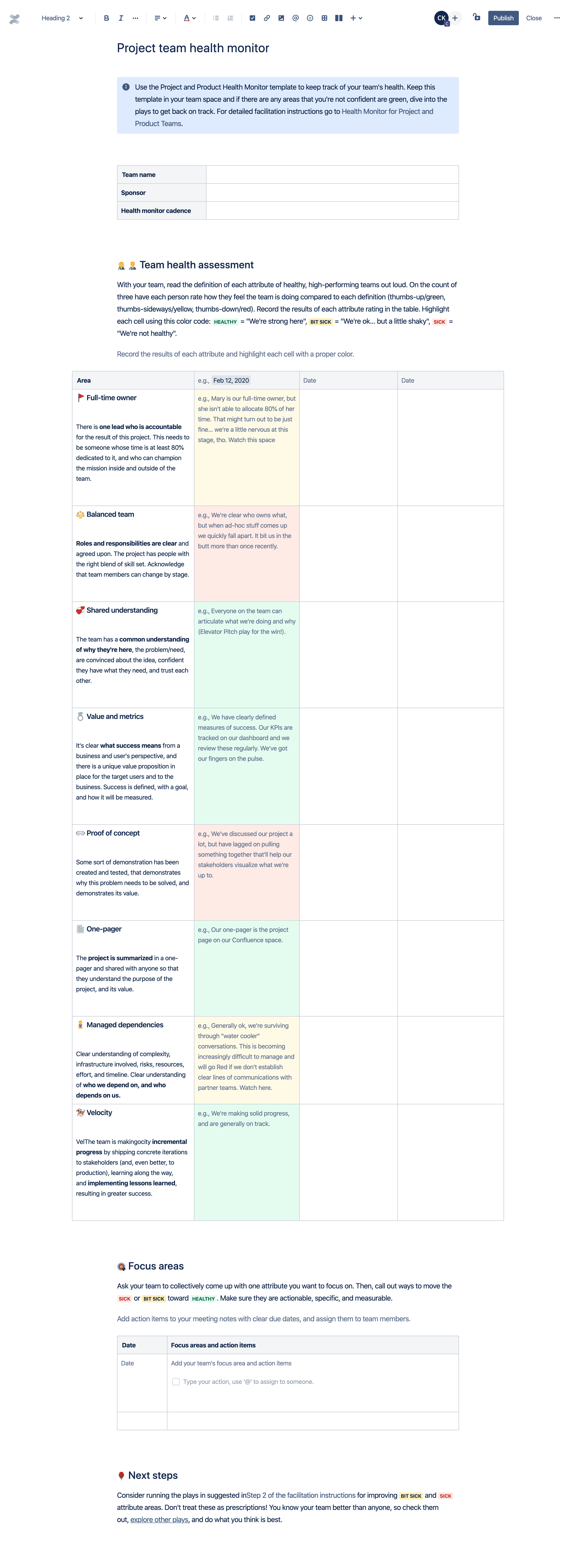
Project team health monitor template
Created by:

Hone your project team’s strengths and address your weaknesses
Categories
- Project Management
- Software & IT
- Page Template
KEY FEATURES
Documentation
Feedback
Team Alignment

When a project team runs smoothly, communication flows, deadlines are met, and you all genuinely enjoy working together. When it doesn’t, well, it’s the opposite of all that. Use this project team health monitor template to find out where your current team falls on that spectrum. You’ll see how you stack up against eight attributes of healthy, high-performing teams – and how you can improve in the areas where you’re falling short. The result? Better collaboration and a killer final project.
How to use the project team health monitor template
- 1
List the facts
Record the more factual information at the very top table of the template, including the name of your project team, your sponsor, and your cadence. Health monitors work best when they’re done on a frequent basis. So, plan to run one at least bi-weekly or monthly, depending on the duration of your specific project.
- 2
Round up your project team
Because health monitors assess the performance of your team as a whole, they’re collaborative activities. Yep, that means everybody needs to be in on this together. It’s time to gather your project team for a scheduled time when you can complete an honest assessment of what’s going well and what isn’t. If this is your first time running a health monitor, plan for at least an hour of time. You want enough time to thoroughly discuss your strengths, weaknesses, and next steps.
- 3
Get an honest read on how your project team is doing
The bulk of the template is dedicated to the Team health assessment table, and this is where you’ll roll up your sleeves and have a candid conversation about how your team is doing.
Each row of the table lists an attribute of a healthy, high-performing team (such as shared understanding or team balance). Read the first attribute aloud to your group. On the count of three, ask everybody to rate how they think your team is doing compared with that definition using this system: thumbs-up (green), thumbs-sideways (yellow), and thumbs-down (red).
Agree on an official rating together, record that in the table along with some notes about your reasoning, and then assign the appropriate color to that cell. Repeat that same process for every attribute in the table.
Each time you run a project team health monitor in the future, record the date at the top of the next column and add your new ratings there. You’ll be glad to have that historical record of how you’ve progressed.
- 4
Identify your focus areas
Throughout this process, you’ll uncover some things your team is doing exceptionally well – along with some areas for improvement (remember, that’s the whole point!).
Your goal is to get any red and yellow areas moved to green, which is going to require some elbow grease. Keep this process manageable by asking your team to agree on one area that they think you should focus on first, as well as some specific or actionable ways you can boost your performance in that area.
In this Focus areas section of the template, list the date and the attribute you’ve agreed to work on. Underneath that, add action items with due dates and team member assignments so that you can take steps toward improving. Remember, information is only information if you don’t take action on it.
Why Confluence?
Confluence is a connected workspace that empowers teams to create, organize, and share knowledge. Easily create content, like dynamic pages, collaborative whiteboards, structured databases, and engaging videos. Pull in all your work to reduce context-switching and turn scattered information into a single source of truth.
Flexible and extensible, Confluence is used by all types of teams, from marketing to technical teams and program management to sales teams. With 100+ free templates, Confluence makes it easy for teams to get started quickly and efficiently.
Related templates
Partners
1 on 1 meeting template
Run 1-on-1 meetings and maintain productive working relationships.
Business Strategy
4Ls retrospective template
Use this template to conduct a 4Ls retrospective with your team.
Business Strategy
5 whys analysis template
Use this template to conduct a 5 whys analysis and discover the sources of team problems.